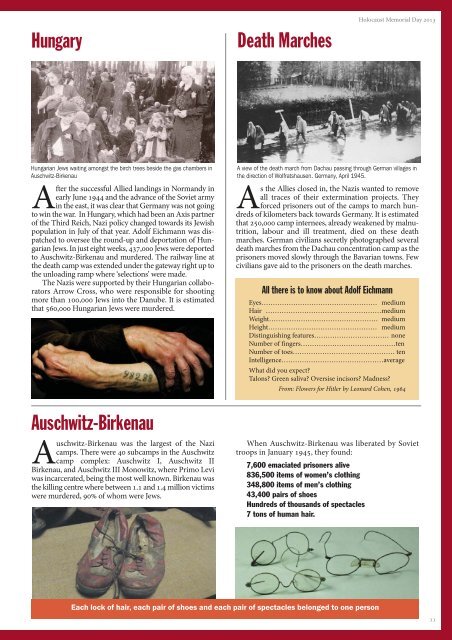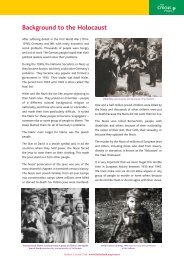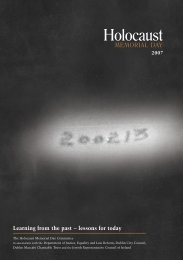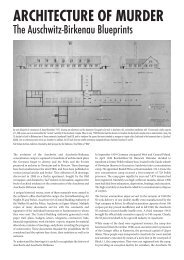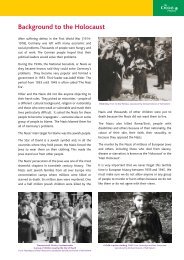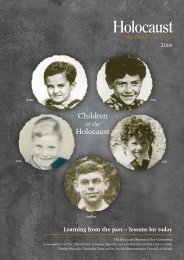19505_HMD_Cover:Layout 1 - Holocaust Education Trust Ireland
19505_HMD_Cover:Layout 1 - Holocaust Education Trust Ireland
19505_HMD_Cover:Layout 1 - Holocaust Education Trust Ireland
Create successful ePaper yourself
Turn your PDF publications into a flip-book with our unique Google optimized e-Paper software.
Hungary<br />
Death Marches<br />
<strong>Holocaust</strong> Memorial Day 2013<br />
Hungarian Jews waiting amongst the birch trees beside the gas chambers in<br />
Auschwitz-Birkenau<br />
After the successful Allied landings in Normandy in<br />
early June 1944 and the advance of the Soviet army<br />
in the east, it was clear that Germany was not going<br />
to win the war. In Hungary, which had been an Axis partner<br />
of the Third Reich, Nazi policy changed towards its Jewish<br />
population in July of that year. Adolf Eichmann was dispatched<br />
to oversee the round-up and deportation of Hungarian<br />
Jews. In just eight weeks, 437,000 Jews were deported<br />
to Auschwitz-Birkenau and murdered. The railway line at<br />
the death camp was extended under the gateway right up to<br />
the unloading ramp where ‘selections’ were made.<br />
The Nazis were supported by their Hungarian collaborators<br />
Arrow Cross, who were responsible for shooting<br />
more than 100,000 Jews into the Danube. It is estimated<br />
that 560,000 Hungarian Jews were murdered.<br />
A view of the death march from Dachau passing through German villages in<br />
the direction of Wolfratshausen. Germany, April 1945.<br />
As the Allies closed in, the Nazis wanted to remove<br />
all traces of their extermination projects. They<br />
forced prisoners out of the camps to march hundreds<br />
of kilometers back towards Germany. It is estimated<br />
that 250,000 camp internees, already weakened by malnutrition,<br />
labour and ill treatment, died on these death<br />
marches. German civilians secretly photographed several<br />
death marches from the Dachau concentration camp as the<br />
prisoners moved slowly through the Bavarian towns. Few<br />
civilians gave aid to the prisoners on the death marches.<br />
All there is to know about Adolf Eichmann<br />
Eyes…………………………………………… medium<br />
Hair ……………………………………………medium<br />
Weight………………………………………… medium<br />
Height………………………………………… medium<br />
Distinguishing features…………………………… none<br />
Number of fingers……………………………………ten<br />
Number of toes……………………………………… ten<br />
Intelligence………………………………………average<br />
What did you expect<br />
Talons Green saliva Oversise incisors Madness<br />
From: Flowers for Hitler by Leonard Cohen, 1964<br />
Auschwitz-Birkenau<br />
Auschwitz-Birkenau was the largest of the Nazi<br />
camps. There were 40 subcamps in the Auschwitz<br />
camp complex: Auschwitz I, Auschwitz II<br />
Birkenau, and Auschwitz III Monowitz, where Primo Levi<br />
was incarcerated, being the most well known. Birkenau was<br />
the killing centre where between 1.1 and 1.4 million victims<br />
were murdered, 90% of whom were Jews.<br />
When Auschwitz-Birkenau was liberated by Soviet<br />
troops in January 1945, they found:<br />
7,600 emaciated prisoners alive<br />
836,500 items of women’s clothing<br />
348,800 items of men’s clothing<br />
43,400 pairs of shoes<br />
Hundreds of thousands of spectacles<br />
7 tons of human hair.<br />
Each lock of hair, each pair of shoes and each pair of spectacles belonged to one person<br />
11


